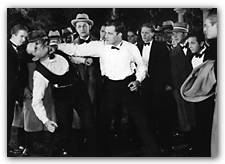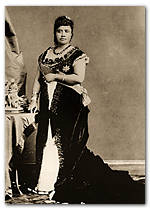Main Menu · Search ·Current Issue ·Contact ·Archives ·Centennial ·Letters to the Editor ·FAQs
![]()
| The Government We Need | Films: 23-Skiddo and Aloha |
| Off The Shelf | Chapter & Verse |
| Open Book: The Abduction of Phil Esposito | |
![]()
 Brown of Harvard slugs a rival.Photograph courtesy the Museum of Modern Art/Films Stills Archive |
When the play Brown of Harvard opened in Boston in 1909, students from Cambridge showed up at the theater and pelted the actors with vegetables. The assault was vigorous enough to bring down the curtain and truncate the performance. No such protest greeted the premiere of the eponymous silent film in 1926; expect an even milder reaction to the current video release, 70 years later. As a story, Brown of Harvard richly deserves both stony silence and airborne zucchini. Yet as an archaeological relic it makes absorbing viewing.
A film like Brown of Harvard holds our interest not because it accurately
depicts the Harvard of the early twentieth century, but because it authentically
renders that era's mythology about Harvard. Using all the hyperbole and
caricature one would expect from  Hollywood,
the movie sketches a thin, melodramatic story about a cocky, unlikable Harvard
undergrad who battles a male rival for athletic success and the favor of a young
beauty. Tom Brown (named perhaps in allusion to the 1857 novel Tom Brown's
Schooldays) is a boorish, arrogant lout, a witless wiseacre who sports a
"sheik belt": "Whenever a new girl falls for me, I cut another notch in it,"
he smirks. Despite its owner's repellent personality, the Brown belt shows many
notches, a fact explicable only by reference to Tom Brown's good looks, credibly
realized by leading man William Haines.
Hollywood,
the movie sketches a thin, melodramatic story about a cocky, unlikable Harvard
undergrad who battles a male rival for athletic success and the favor of a young
beauty. Tom Brown (named perhaps in allusion to the 1857 novel Tom Brown's
Schooldays) is a boorish, arrogant lout, a witless wiseacre who sports a
"sheik belt": "Whenever a new girl falls for me, I cut another notch in it,"
he smirks. Despite its owner's repellent personality, the Brown belt shows many
notches, a fact explicable only by reference to Tom Brown's good looks, credibly
realized by leading man William Haines.
The narrative turns on a series of howling implausibilities. On the morning of the Harvard-Yale crew race, for example, Brown, long since dropped from the squad, suddenly appears in the stroke seat of the varsity boat--despite having gone on a severe bender the night before. Predictably, he collapses just before the race's finish. Later, Brown redeems himself by switching to football and winning The Game with several sparkling runs. In the locker room at half-time, the Harvard coach encourages his players with the admonition that there are "80,000 fans watching you." Say what? Squeezing 80,000 fans into Harvard Stadium would be an even bigger accomplishment than beating Yale.
The film includes some stirring footage from an actual Harvard-Yale football game, and communicates a bit of the magisterial awe that The Game commanded in the Roaring Twenties. Flapper attire, '20s dance steps, and views of trolley tracks bisecting Harvard Square also evoke the decade, and familiar sights like Widener Library and Memorial Hall evoke the eternal Veritas as well. The script even verges on plausibility in a scene in which a Crimson story tells how the football team has cut Brown from the squad--a report soon discredited. Even the passage of 70 years leaves some facts of life untouched.
 A royal Hawaiian. |
As the Marines were marching on the palace in 1893, the Royal Hawaiian Band
continued their concert at a Honolulu hotel; the military coup was  bloodless,
a fact that may partly explain why Hawaii's annexation has received so little
scrutiny. That, and its shameless imperialism. This documentary will correct
any lingering impressions that the islands were eager to become an American
territory.
bloodless,
a fact that may partly explain why Hawaii's annexation has received so little
scrutiny. That, and its shameless imperialism. This documentary will correct
any lingering impressions that the islands were eager to become an American
territory.
When Westerners arrived in 1778, there were 800,000 Hawaiians; 80 percent of them had perished within 50 years. "Hawaiians were dying of disease and cultural malaise," one commentator explains. The advent of white missionaries and the rise of wealthy white sugar growers set the stage for the events of 1893, when the government in Washington backed the sugar interests over the native peoples.
Hawaii's Last Queen lapses into the underwhelming visual style that characterizes many public-television documentaries: still photographs, talking-head interviews, "beauty shots" of landscapes and surf. Yet Ducat's research offers up a wealth of fascinating details, like the fact that Lili'uokalani composed Aloha Oe ("Farewell to Thee"), perhaps the best-known Hawaiian song. When heard over the film's end credits, the melody assumes a special poignancy.
~Craig Lambert